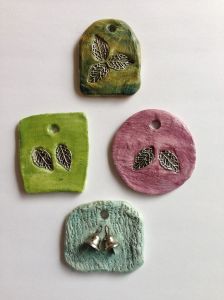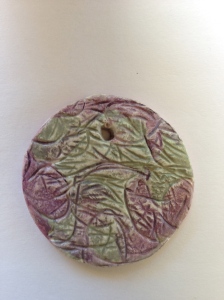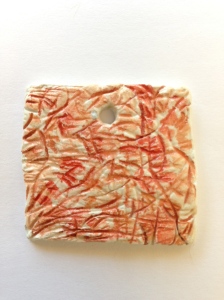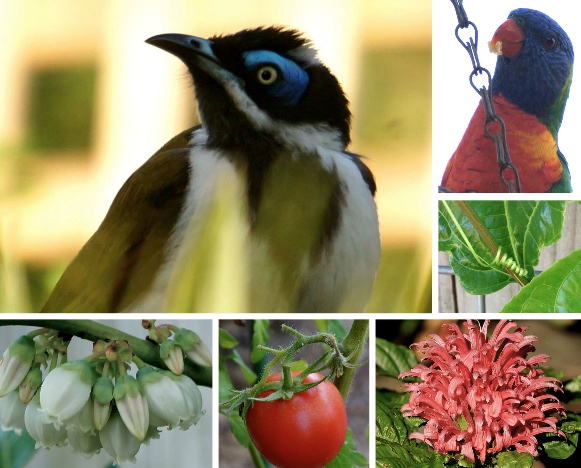Following on from yesterday’s post, here are the last of the ‘clay objects with holes’ from the second batch of clay.
Monthly Archives: November 2013
small pleasures: clay play
What started out as a thought to make tree decorations and gift tags for the coming Christmas season became a bit of a fun production line over the last couple of days.
One kilogram of air dry clay (or 2.2 lb) made around 70-80 of these trinkets. The images are samples of the first batch. No oven required. There are 40 more still lined up waiting to dry (at least 24 hours required) before they get painted, dried again, glossed and added to the collection. The largest of the circles are around 4.5 cm in diameter to give you some indication of the scale.
The best part of making these are the surprises that emerge from apparent mistakes. There could be a metaphor lurking in that sentence.
receptive is creative
In 2008 Stephanie Dowrick wrote a doctoral thesis entitled Rainer Maria Rilke: Bearing Witness. Around the same time she completed In the Company of Rilke: Why a 20th-century visionary poet speaks so eloquently to 21st-century readers yearning for inwardness, beauty and spiritual connection.
I would not have known this had I not been hovering around the number 831.912 in the local library. German poetry is not my usual go-to shelf. I do, however, own several works by Stephanie Dowrick so when I spotted her name on a book spine I was curious enough to add the book to my underarm clutch.
So how does a not particularly religious person get drawn to the writings of an Interfaith Minister? In my case, I think it’s due to the absence of dogma in her work on spirituality and the human condition. Over the years, Dowrick has explored such topics as resilience, solitude, forgiveness and intimacy. Her words are both accessible and deeply thought provoking.
Dowrick’s thesis description begins thus.
This study of the poet Rainer Maria Rilke (1875-1926) explores both epistemological and ontological themes, explicitly asking what readers may “bear witness to” within themselves, as well as on the page, through their reading. The primary question of the study comes from Martin Heidegger’s essay on Rilke when (quoting Hölderlin) he asks: “What are poets for (in these destitute times)?” and whether this has genuine significance beyond entertainment or diversion.
The book written alongside her thesis incorporates biographical and theological elements. Dowrick expresses impatience and disdain for Rilke the man which contrasts greatly with her response to his work.
Dowrick spends time exploring the accuracy of translated poetry, noting that the translators of Rilke’s work from German to English often created very different interpretations. So it is, with all readings or listenings to poetry in one’s own language, Dowrick argues. We are all translators. The poem becomes what we make of it in the reading, much like our individual responses to spirituality.
The writer’s history shapes what sits on the page; the reader’s own history and conditioning are also inevitably present, shaping the encounter and limiting or delimiting comprehension and appreciation.
Dowrick talks about what she describes as ‘surrendered reading’,
a way of ritualising the meeting point between the writer and the reader that requires a willing letting-in as much as a letting-go. Reading then becomes a brave and profound experience of being, not simply of ‘doing’.
For the reader, Dowrick argues, finishing a (polished) work is the beginning of ‘complex processes of engagement’
The sparks that lit me up in the reading In the Company of Rilke were not necessarily the biographical details of Rilke or the theological elements, although they provided great context. It was about the exploration of the processes of reading and writing.
Reception is critical in reading: I make this point repeatedly. It is no less critical in writing.
Dowrick goes on to quote the French philosopher Gabriel Marcel.
What Rilke teaches us better than anyone, and what I think such writers as Neitzsche or Kierkegaard have generally either never known or in the end forgotten, is that there exists a receptivity which is really creation itself under another name. The most genuinely receptive being is at the same time the most essentially creative.
If the success of a book or poem is that the reader begins a ‘complex process of engagement’ once the ‘reading’ is over, this book has worked a treat.
crested pigeon
rebooting in the garden
I was in the office all day yesterday (as I am likely to be again today) working my way through a lot of content to develop a legible and useful document for a client.
I hit the wall mid-afternoon and headed out into the garden for a breather and a change of focus.
The label on the blueberry plant indicates that full sun and moderate water are required. It also says that the plant is suitable for culinary use which is good news since that’s why I bought it in the first place.
In the beginning it struggled and a couple of months ago things weren’t looking good for it. Now there are tiny white flowers emerging and I hope that means that the first berries will set soon.
I can’t say the same for the passionfruit vine which also gave cause for concern recently. There is certainly vigorous new growth, but apparently it will not bear fruit as all the growth is coming from its root stock. Ever reliable, the tomatoes are soldiering on.
Underneath the bird feeder the Justicia is blooming red all over. There was lots of bird action going on too. The Blue-faced Honeyeater patiently waited in the queue as apparently yesterday it was the turn of the lorikeets to be at the top of the hierarchy.
Vale Doris Lessing
I am in no way qualified to write an obituary for a Nobel Prize winning author. The Guardian has a short tribute here to Doris Lessing who died yesterday in London.
What I’m reflecting on as I take my mind back lots of years to the Women’s Studies course in the English Department of UQ is that I was much too young to properly appreciate or indeed understand her work. Thus it was that The Golden Notebook was retrieved from the book shelf today to see if I am ready to fully appreciate this work.
It appears that Ms Lessing did resonate with me somehow back in my youth. There’s a fairly lengthy preface in this edition, written by Lessing in June 1971 nearly 10 years after the book was published.
I suspect that I paid particular attention to the preface while looking for clues to complete an essay or assignment. This segment, heavily underlined in my copy, apparently resonated with me then, as it does now.
“There is only one way to read, which is to browse in libraries and bookshops, picking up books that attract you, reading only those, dropping them when they bore you, skipping the parts that drag – and never, never reading anything because you feel you ought, or because it is part of a trend of a movement. Remember that the book which bores you when you are twenty or thirty will open doors for you when you are forty or fifty – and vice versa. Don’t read a book out of its right time for you. Remember that for all the books we have in print, are as many that have never reached print, have never been written down – even now, in this age of compulsive reverence for the written word, history, even social ethic, are taught by means of stories, an the people who have been conditioned into thinking only in terms of what is written – and unfortunately nearly all the products of our educational system can do no more than this – are missing what is before their eyes. [ .. ]
Everywhere if you keep your mind open, you will find the truth in words not written down. So never let the printed page be your master. [ .. ] you should be learning to follow your own intuitive feeling about what you need: that is what you should have been developing, not the way to quote from other people”.
Hmmmm.
poems by Mal Andersen
 Here’s some more poetry straight off my bookshelf.
Here’s some more poetry straight off my bookshelf.
Mal Andersen was a school teacher writing short poems in the 1970s. I haven’t been able to find anything more of him or his work after that date. This collection, discovered in a local bookshop way back when Anderson was writing, was published in 1978 by the then North Brisbane College of Advanced Education at Kedron Park (now part of the Queensland University of Technology).
I’ve included three of the poems from Brisbane Poems and Other Recollections below.
.
.
.
California dreaming at QAG
A visit into the city for a morning appointment turned into a good excuse for an impromptu visit to the Queensland Art Gallery to see the California Design 1930-1965 exhibit. Fresh from its appearance in Auckland, this touring exhibition was conceived at the Los Angeles County Museum of Art and displayed there in the latter half of 2011.
It’s a beautifully staged display. There is furniture and fashion, ceramics and jewellery, art work for album covers, book sleeves, magazines and catalogues, not to forget house plans, household objects and children’s toys. A shiny aluminium Airstream Clipper graces the area outside the exhibition entry.
Armed only with my iPhone (another Californian design), I captured a few images, grateful for the fact that many of the best galleries around the world have abandoned any no photography policies they had in the past.
California Design is at QAG until 9 February 2014.
poem: after the storm
tanka poetry by Harryette Mullen
Here’s a great example of what happens you muster the courage to put what you love to do out there in the big wide world. I never cease to be amazed what connections you can make through the magic of social media and blog platforms. What’s even better is when you get the chance to meet those people face-to-face and share conversations about passions and pastimes.
So it’s a big THANK YOU to Deb Reynolds, one extraordinary Canadian, who pointed me in the direction of this post this morning. Thanks for noticing the tanka love coming from this direction Deb, and for helping to open up my knowledge of how others are using and adapting the form.
A container such as verse form is useful to get the writing started. It doesn’t have to mean you’re ‘stuck’ with the format. Enjoying the playfulness of it is an important place to start.
This book review of a collection by Harryette Mullen is from National Public Radio. With these tanka forms, the 31 syllables goes into 3 lines, but not necessarily fixing the number of syllables for each line. Here’s a taste.
Tasting artisan chocolates,
hard to choose between Shangri-La
with goji berries or Aztec flavored with smoky chilies.
The review’s author Carmen Giminez Smith writes about how Mullen marries the modern with the older form.
Poet Harryette Mullen makes a beautiful marriage between those new ideas and a classic poetic form in her first collection in over a decade, Urban Tumbleweed: Notes From a Tanka Diary.
The tanka is a Japanese form dating back centuries. It’s a 31-syllable poem that usually includes what Mullen calls “a refined awareness of seasonal changes and a classical repertoire of fleeting impressions.” In Urban Tumbleweed, Mullen has written 366 tankas, describing a year of living in Los Angeles and traveling to places like Texas, Ohio and Sweden while taking careful note of the natural world around her.
Here’s some more about Harryette Mullen and her work.
So many poets, so little time!
on lethargy – a tanka
poem: the calculation of conversions
This morning, as I was in my office preparing for two workshop facilitations next week, there was a knock on the door. A very sweet elderly couple greeted me. Here are my cogitations on that encounter.
the calculation of conversions
I know you are bringing a message
putting your offer out there,
eager to read from that bible you hold
but don’t, please don’t, proffer your fare
to me.
I’m wondering just how you measure
the numbers you might convert.
do you calculate one in a thousand
and how is that possibly worth
your time?
I’m feeling a little mean-hearted
at sending you both away.
would a cup of tea offer have hurt me?
This, my atheist prayer today.
Amen.
Lynn Buckler Walsh
























































